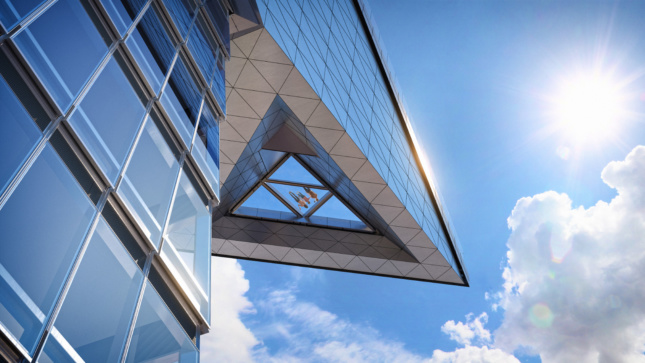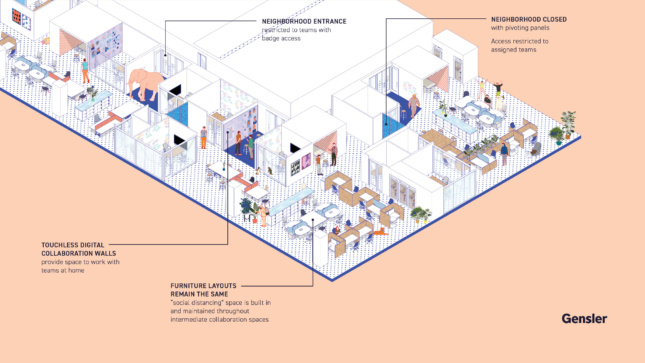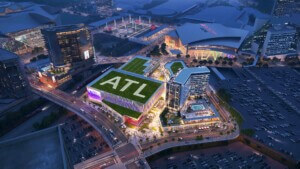On March 11, 2020, Edge, a $36-per-head cantilevered sky-deck attraction on the 100th floor of 30 Hudson Yards, opened to literal fanfare. Early that morning, a private grand opening ceremony kicked off with a brass band and concluded with a performance by aerial dancers, who leaped from the peak of the 1,300-foot-tall skyscraper and proceeded to twirl, twist, and flip high above the heads of the assembled crowd.
But uncertainty also hung in the air. A nascent health crisis continued to unfurl itself across the globe—first in China, then in Italy, then in Seattle, California, and eventually New York City. Prepared remarks from the architects and developers alluded to the fast-moving novel coronavirus, but people still shook hands. Like the amusement park in Pripyat, Ukraine, a few miles from Chernobyl, Edge was open only one full day before it was shuttered on March 13, in accordance with Governor Andrew Cuomo’s restrictions on gatherings of 500 people or more, intended to curb the spread of COVID-19. (Unlike that ill-fated amusement park, however, Edge plans to reopen.)
In a way, the opening of Edge, a tourist attraction at the top of a skyscraper, capped off New York’s commercial building boom. In September 2017, the New York Building Congress announced that new office construction in Manhattan had reached a 30-year high and projected that 2.3 million square feet of office space would be completed that year, followed by 7.2 million in 2018 and 5.6 million in 2019, the year Hudson Yards opened. That is a total of 15.1 million square feet, much of it spread over glistening new towers designed by the likes of Rogers Stirk Harbour + Partners; Pelli Clarke Pelli Architects; and Skidmore, Owings and Merrill (SOM).
As of this writing, nearly three months after Edge’s opening, these shiny office towers remain vacant, as workers who were not laid off or furloughed as a result of the COVID-19 crisis continue to carry on remotely. Although tentative reoccupancy plans are beginning to emerge for workplaces across the city, the future of commercial office space is still fuzzy, as companies reassess their policies and end-of-the-office hype continues apace.
In the view of architects and experts who spoke to The Architect’s Newspaper, however, Manhattan’s abundance of grade-A office space isn’t going anywhere. The city itself, Hudson Yards and all, will bounce back. If anything, they suggested, the coronavirus pandemic will accelerate existing, employee-benefiting trends in the long term and lead to workplaces that are more social and healthier and offer greater flexibility.

“This whole crisis is potentially going to be a catalyst for change,” said Laura Ettelman, managing partner at SOM and a member of Mayor Bill de Blasio’s construction and real estate reopening advisory council, one of ten sector advisory councils the mayor established to help with reopening and recovery efforts in the wake of the pandemic.
“The urban community is going to survive,” Ettelman said. “Human beings are social creatures, and we thrive on the things that our urban centers offer to us. We will see people go back to the urban center in the same way they did after 9/11. It took some time, but people went back to building tall buildings, and people went back to flying on airplanes. And the city has been able to thrive since that crisis.”
And it would seem that workers, social creatures that they are, are already itching to get back into the office—at least for some functions.
Gensler Research Institute recently asked more than 2,300 U.S. office workers if they wanted to work from home on a full-time basis. Only 12 percent said yes. Most of those who said no cited one reason: the lack of regular face-to-face interactions with colleagues. Put simply, they miss being around other people.
“Most people do want to return to the workplace,” said Ben Tranel, principal at Gensler and author of “How Should Office Buildings Change in a Post-Pandemic World?,” an article published by the global architecture and design firm on its website as part of its ongoing series on design responses in the COVID era.
“As we’re contemplating how we return to the office—and all kinds of spaces and built environments around us—I think what’s top of mind for all of us is this: How do we make that an experience that’s safe so that people will feel comfortable?” Tranel asked. “And also trying to assess what will be the longer-term, lasting changes that we make as a result of this experience.”
He added: “A common theme that seems to emerge is that this type of event, a cataclysmic event like this, tends to be an accelerator of trends that were already in place.”
Brent Capron, interior design director at Perkins and Will’s New York office, believes that wellness-centered design will play into these longer-term changes.
“I would love to see us rethinking: Is there an architectural model that isn’t a center-core building? It would be interesting to see if New York could start coming up with more interesting designs and bring wellness to the forefront,” said Capron, referencing the Ford Foundation building as a precedent that deviated from the norm. “Can we find ways to cut more holes in existing buildings and turn nonatrium buildings into atrium buildings? And can we bring back operable windows?”
Added Capron: “If we have this glut of commercial office buildings, let’s cut into it. Let’s convert it and open it up.”
Melissa Marsh, founder of social research and workplace strategy organization PLASTARC and senior managing director of occupant experience at global real estate services provider Savills, agreed that wellness, already a leading office design trend pre-COVID, will grow in importance alongside sustainability and what she calls “purposeful occupancy.”
Wellness considerations, such as natural ventilation and lighting, biophilic design elements, and a workplace culture focused more on flexibility, self-care, and stress management, are “going be as significant or more significant going forward,” Marsh said. “Each of these things that we knew and were already pursuing have [gained] a new layer of meaning or relevance.”
Marsh and Capron agree that if Manhattan’s largest commercial leaseholders do bestow greater flexibility on employees, as is anticipated, vast, isolating, cubicle-dominated floor plates will need to go.

“It’s more important than ever before that the places where we are coming together have an intense level of sociability and experience and importance, because that’s the piece of the work experience culturally—certainly physically—that you wouldn’t get from the virtual version,” Marsh said. “There isn’t the advantage that people think there is of having one-to-one space allocations per person. The corporate campus should be about the corporate experience, not about a container for accommodating the specified head count, and that’s part of this evolution from an industrialized version of work, which is ‘Thou shalt report to a cubicle at 9:00 a.m. every day.’”
“We could have worked from home before this,” said Capron. “But there’s something about bigger cities—the pride of these cities—and the gorgeous urban experience that people are going to want to have.”
Capron does note that there is the potential that some office space will be made redundant as employers adjust to new, potentially less physically expansive modes of working. And this could lead to other opportunities. “Maybe [redundant commercial real estate] converts to residential so we can spread out a bit more and aren’t on top of each other in our apartments. And people can afford apartments again.”
“It’s an opportunity to create more live-work communities by shifting and changing some of the use of buildings,” said Ettelman of the “interesting” prospect of converting commercial office space into housing. “Thinking about how to improve the pipeline of delivering more housing is an important thing in the city.” She does note that “there are many things we would also need to change in those buildings and adapt to shift an office building to a residential building.”
Vishaan Chakrabarti, founder and creative director of Practice for Architecture and Urbanism (PAU), believes that aside from a “little bit of shrinkage” in the demand for office space, sweeping long-term changes to how and where we work simply aren’t in the cards. He said that there will be no working from home in perpetuity or enclosing individual workspaces within plastic bubbles. He also referred to the influx of pandemic-related speculative designs as a result of people being “short-term histrionic,” adding, “I think it’s a weird vestige of the Corbusian architect-as-god model, and I saw this a lot after 9/11, too, where architects want to feel as relevant as firefighters. We’re not first responders, we’re second responders. Our responsibility is to really think about how to reimagine things in the aftermath of crises.”
“Do I think there will be more of an emphasis on healthy workplaces coming out of the pandemic? I do,” Chakrabarti said. “Do I think it’s going to be because people are somehow going to think that even after a vaccine [is available], that they’re going to catch something from their coworkers? No, I don’t.”
Between the deep need for social interaction in the workplace and the intoxicating pull of large urban centers, it becomes clear that New York’s office workers will return to their desks. Perhaps they’ll be there a little less often. Maybe there will be changes and some bumps at first, as both the city and companies adjust. But Hudson Yards will survive. New offices will continue to be built across the city. Edge will reopen.
“There’s a whole group of people who just insist on thinking that the only reason that we all live in cities is that we have to, not because we want to,” said Chakrabarti. “And that’s the piece that no one’s getting about this—that this desire line is not going to go away because of a virus.”










